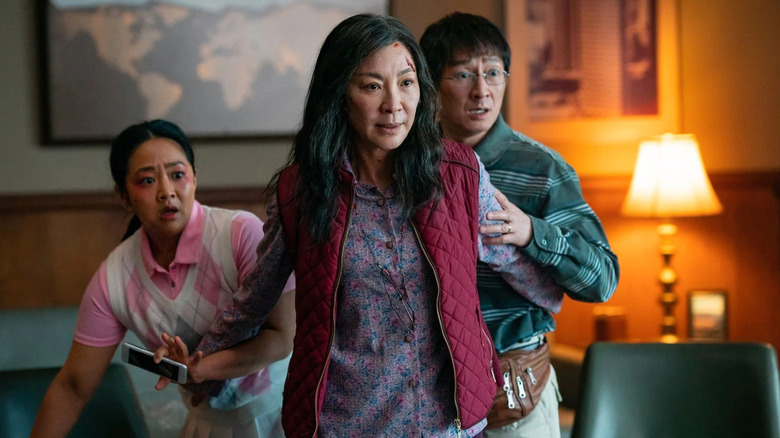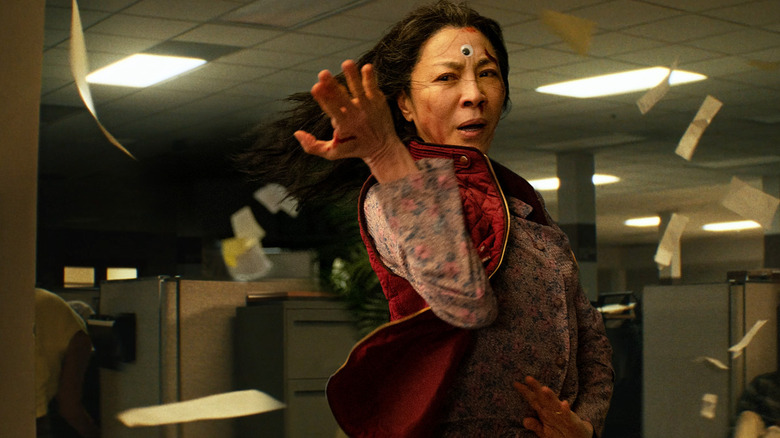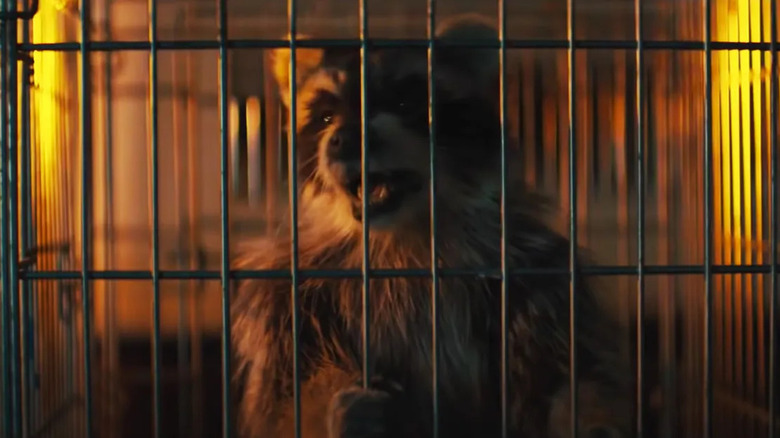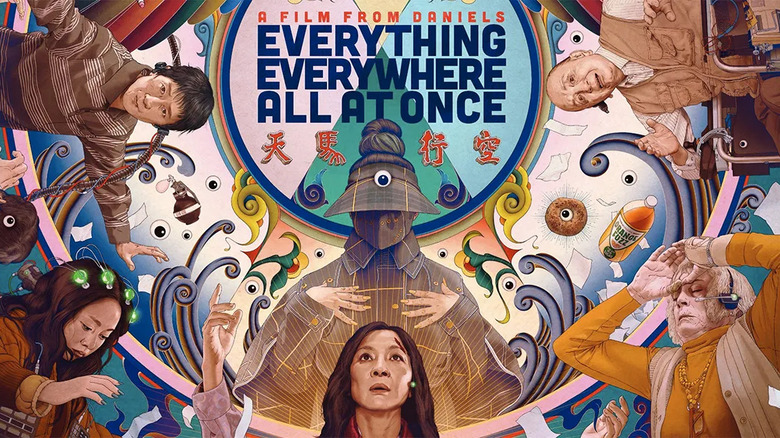Everything Everywhere All At Once Re-Recording Mixer Brent Kiser On Handstand Contests And Raccoons [Interview]
Brent Kiser is all smiles talking about "Everything Everywhere All At Once." The day we talked to the re-recording mixer, however, he was dealing with a flood at the Unbridled Sound office and a landlord stuck in Russia.
"It's been great," he said. Although the off-screen Zoom chaos was oddly appropriate for talking about the Daniels' mind-expanding film, it didn't dampen Kiser's enthusiasm when discussing the film and his collaborators.
Kiser is now one of the Daniels' go-to collaborators. The writing and directing duo used a lot of the same crew from "Swiss Army Man," including the re-recording mixer. The process sounds like a pack of friends experimenting, yet maintaining a single vision. As Kiser told us in a spoiler-filled interview, filmmakers Daniel Kwan and Daniel Scheinert create an ideal environment to create and collaborate.
Spoilers follow for "Everything Everywhere All At Once."
"We need to feel like everything's coming in and everything's going."
[Note: We're starting after Brent returned from a flood-related phone call]
So you wish every film experience was like this one?
They create an amazing environment ... where it's, when things go wrong, it's never a yell, it's never "What the f***." It's literally, we all jump in together and like we're playing in our backyard and be like, all right, cool. This sucks. How do we make it better? I don't know, you want to jump from the top of the roof? Yeah, f*** it. Let's do it. And so, a lot of the times with sound, it'd be like that, this isn't working. You want me to do something crazy? And then we'd do something crazy and they'd be like, "That's crazy. I don't like it." Me neither, so we'd figure something out.
The great thing with the Daniels is allowing for discovery, because it's your favorite song, my favorite song, it came from that moment of somebody just jamming out and somebody stopping, "Yo, yo, yo. Stop, stop. What'd you do, would you do that again? Do that again."
And that was a great process.
So when were the times, as you said, were like "jumping off a roof"?
The hallway scene was one of the first scenes that I think [the editor] Paul jumped in, because Paul's process was, let's go to the craziest place, establish this and then we'll figure everything else out, which we're a big believer of. We need this to feel like the universe is breaking. We need to feel like everything's coming in and everything's going.
One of the sounds that I kind of created for them, this Hail Mary. I was like, well, what would it sound like? We were talking about radio dialing and stuff, which is kind of funny because it's like, I'm 38. I remember dialing through the radios, but then I'm like, most of these 18 year olds, 22 year olds, they'll be, "You dialed through what? How? What did it sound like?" And so, trying to make it to where it was more accessible all around.
I took these radios, like it changes and made them whooshes. They loved that because it felt like the movement came through, and that was just a Hail Mary. But then they were like, "Yeah, just do something weird." And so, everything went on the ceilings. We're like, oh f*** it. It's Vegas. And so, when we just put these pinball jackpot-like sounds going all around, bouncing around, that was actually Andrew Twite, my right-hand man, sound designer. He pulled that one out because I think I put in, I put like a static stutter and they liked the pinball because it was more playful.
Another happy accident is every time they verse jump, we gave them all of these sounds building up, like a flash sound, like a charge, and all this stuff. We gave them all these gorgeous elements and we're like, "Yeah, just pick whichever one you guys like, put a couple in whatever." And then I talked to Paul and he's like, "Man, that stuff was great. I just played everything all at once." And I was like, really? He's like, "Yeah, and it works." I'm like, "You weren't supposed to play them all."
It's such a clear vision, and yet, it sounded like it allowed for anything goes, somehow.
Well, it's so crazy. The script, when you read it you're like, I get it, but I don't, how is this going to happen? You want to go far and you're like, "Oh, it's a silly moment." And it's like, it is, but it's not. At times, you almost want to play it too straight to make it feel so ridiculous.
She's cooking the noodles and they're going back and forth, that whole opening scene is very rhythmic. This, that, this, move, this. It feels cacophonous. Son Lux's score keeps the pace with all the little percussion stuff. It became, "Oh, we should make this big. Oh, you don't have to make it big. There's a lot here that's making it big."
The movie is almost wall-to-wall sound and score, but how'd you approach the quieter moments?
Well, the big thing that Andrew Twite and I were really nervous about in the pacing of it, a lot of it's like a build, drop, build, drop. And so, we were like, "Oh, we think there are too many risers. We think it's this." But Dan Kwan was like, "No, trust me. This is the tension and release." It was, never let them have a breath. It was, let's have it focused.
The parking lot stuff is really, it's toned down, out of everything else. And that's when we wanted to feel focused and it's just us. There's nobody else in the world. There's nobody else in any multiverse. It's just us.
Did you have certain rules for the different universes?
Kind of. In the fight scene where it's Evelyn and Gong Gong and she's pressed up against a chair and then pinky fu comes out, every time the pinky was there or hit, it was just like a big boomy sweetener. There's another moment where "K-pop Jobu" towards the end, we had autotune things bouncing around because she's K-pop.
It wasn't even necessarily about this universe needing this, but more how does this universe exist in this universe? And so, bringing those characteristics over. When Evelyn falls down the stairs in the end, you actually hear the different universes as she's popping through them. And then the hallway scenes, you're really feeling Looney Tunes coming in. It's not that everything exists individually. Everything exists together, you just have to access it.
"So the butt plug fight, that's the crazy one."
How big did you want to go with the fanny pack fight scene?
So, the fanny pack was our first fight scene that we did. Andrew Twite really took that one. He took that one, I took the shield hit, like an opera singer fight and on this one, so he gets in, he's all excited. His wife, Molly Butler is so obsessed with fanny packs, like literally owns 30 fanny packs. So he said, "I want this scene, I want this scene." I'm like, all right. So all of those like fanny whips, pulls and all that stuff is the collection of his wife's fanny packs. The practical side was there.
Every fight scene had a different inspiration. This one had a very "Kung Fu Hustle" feel. That's a big inspiration in that moment. The question was, how much of this fight scene is whooshes and whips versus just big impacts? What we felt on this one was the acrobatics of everything. Seeing that Waymond can actually do all of this, that was more important to accent those whooshes. As the fight progressed and he sits, puts the rocks in, drops it down, that now he's a bad***, now the audience is used to it. So now you get those slower whooshes, those big booms and just get the grandiose.
[Laughs] Sorry, I'm already laughing before I ask this question, but what were the inspirations for the butt plug fight scene?
Dude, the best reveal is, you don't get one of these unless you deal with a lot of bulls*** [Laughs]. You're just like, ah. So the butt plug fight, that's the crazy one because it's so long. It just goes from fight to fight, to fight into another fight, and by the way, we have more fights. It was really a big one, because how do we separate it? Also, how do we not make it gratuitous? You know what I mean? You didn't hear it slip in. You didn't hear this. This is one of those things where it's odd enough on its own. You don't have to overly sell that it's a butt plug and it's going in somebody's butt. But the thing is, this is the butt plug to end all butt plugs to give and power to do these things.
[Laughs] As you said, some images were odd enough on their own without needing to accentuate them. In that case, how'd you approach the hotdog fingers?
Well, see that one was funny because that was a back and forth between the sound team and the directorial team, because they had messed around. They'd found cat food and started messing around, and that gave it that sloppy sound... But then we were just told like, "Yo, play it straight." So, we had all the leather hands that we had recorded to put in to make these things. It was like, just don't give the same wet feeling just like wet noodle hands. So that one, the cat food ended up really shining on that.
When the bagel that bonds the universes together is revealed, how did the sound team decide how grandiose to go in that moment?
That was really hard, too. Dan Kwan had a vision for that one, but then it was one of those moments of f*** it. Throw it all in. We made it huge. What does everything sound like? Wow. What we ended up falling back to was a cyclical nature. It's circular, it's never ending, it helps tie in with the laundry. We were able to find this rhythmic chunk and I think we, Andrew and I, found influence from the laundromat stuff. I mean, it took a lot to find that one. That was a lot of back and forth. Plus, we were getting new iterations. Side note: Zak Stoltz, the special effects supervisor, it was him and five other dudes. That's the whole visual effects team.
How's that possible?
Right? Well, to be honest, because most of the visual effects stuff are practical. When Evelyn gets shot back for the first time into the closet, that's just a slow shutter speed. And they're just pushing her back and just speed it up, and that's what it looks like.
The raccoon is a great puppet.
Raccacoonie, man, that was Randy Newman, by the way. He came in. Wait for it, Son Lux has actually extended the Raccacoonie song to a full song that'll be released on the soundtrack.
How was it collaborating with Randy Newman?
It was great. Julie Diaz, the ADR supervisor, was with everybody there. They went to the village in Los Angeles, he's a total pro and also like, what is this? Why not? The other thing is, everybody was just so excited about this because it was so different, but it's not different for the sake of different. It's accessible. That's the joke about "Swiss Army Man" and this, the whole time you're like, "What the f***, and also, why am I crying? What is going on?"
Like the alleyway sequence after the premiere. How'd you want to help the emotion there?
So the big thing in the Hong Kong alley is really just feeling that rain, feeling the city, feeling it, making it. The big inspiration for that was "In the Mood for Love." It's not only just this precious moment, but when we watch movies, it's what we think love can be. So, how do I do that with sound? It's like, "Oh, put in that dramatic rain. Put in the street traffic." Ke Huy Quan, come on, dude, 20 years off the acting and comes in and kills it. And just showing the depth because now he's like this swank guy telling these emotions.
"We started every mix with handstand contests."
How'd you want to pay homage to the Shaw Brothers films and Jackie Chan's work? Did you also take any inspiration from any of Michelle Yeoh movies?
Oh yeah, yeah. I mean, of course "Crouching Tiger, Hidden Dragon," because we really had to study what hits sound like. So, Paul Rogers is part of this picture editorial company called Parallax Post. I's him and a couple other guys, but one of the other main editors is Luke Lynch. We've had this huge discussion for the past four years about the "Drunken Master," so this became a huge conversation for this piece. When Jackie Chan's "Drunken Master” was made, it was made in Cantonese originally.
And then it was dubbed into Mandarin and then the American version came and Luke Lynch's goal in life was to get the original Cantonese, but with the dubbed version, because what the Cantonese did, it was all about rhythm. The hits are off, not necessarily grabbing the right wind, but it makes a rhythm. The Mandarin got a little bit away and then in the American version, they just did it straight, fully. So it sounds how it's supposed to sound. We're not getting the whooshes, so we went back to study that and we went back to earlier films of Michelle's, "Crouching Tiger, Hidden Dragon," and that movie was when kung fu kind of changed because no longer is it about these really quick, quick, quick, whooshes.
When you watch the older "36 Chambers of Shaolin," all that sort of stuff it's hit, crack. Now, we had that in the butt plug fight, we had like magical moments, but then with going up the stairs, the whooshes became more air-like, air elegant and the hits were strong and percussive. And so, watching her movies, we studied those different things and tried to be as true to that as possible.
So you kept returning to the sound of washing machines. What were some other running themes?
Rise was a big thing. Like rising and coming out. It wasn't necessarily about certain sounds, but taking practical sounds and bringing them up and then coming down. Even with the mirror. The front shot where the mirror shakes, it's like the music and it shakes. It's practical moments that will bring us back, but then at the same time, these practical moments will rise us in because a lot of it was using the laundry machine to bring up the anxiety and then dropping us out. It is really just how we can use practicals for that build-drop, I think would be one of the big things.
Since this movie is so dense, although we've covered quite a bit, any stones we've left unturned?
Literally stones, how about that? I mean that. Everybody was like, "Oh, the fight scenes were rad." And I was like, "Yeah, but those stones..." Just breaking down the wind and stopping, it's huge. I mean, it's a Monty Python joke, I feel like. And these things are just great, but I really love the stones, the simpleness. Especially at the end when it becomes more grandiose. I like that. Is that where I want to leave this out?
Well, let me shout out my team because honestly, without them, we're nothing. And one thing I've learned from Daniels is that the crew is the most important thing. And that's what they do so brilliantly is they put more effort on the crew than they do on erroneous things. If we could have mixed this in somebody's bedroom, they would've wanted that so that I could make more money. You know what I mean? Because they're like, you are the important one.
Andrew Twite and I've known each other since college and there would be no Unbridled Sound without Andrew Twite. [Re-recording mixer] Alex Fehrman came on this project to help me mix it at the last second. The vibe was so right with her that it was just magical and just made it feel better.
We started every mix with handstand contests. Dan Kwan and Dan Scheinert can't really do handstands, but they didn't give a f***. They just started going with us, and it was great. Daniel Raphael was our dialogue editor, and he is truly one of the most unsung heroes of every project he's on because he's able to find alts and make things feel so effortless on something that's so hard and tedious. [Sound effects editors] Kailand Reilly and Jacob Flack came in and helped Andrew and I, because, man, it was a whirlwind.
I think we had seven weeks of editorial. That time is nothing for what we were able to achieve. So, we wouldn't have been able to do without them. There's Julie Diaz, our ADR supervisor. She's amazing and everybody loves her. So it's like, her being around talent and these things, she's able to make them feel so comfortable. It's amazing. I'm sure I'm forgetting people, but...
Well, congratulations to you and everyone you mentioned.
Thank you. I feel like I have to retire now, because it's only downhill from here.
"Everything Everywhere All At Once" is now playing in theaters.



